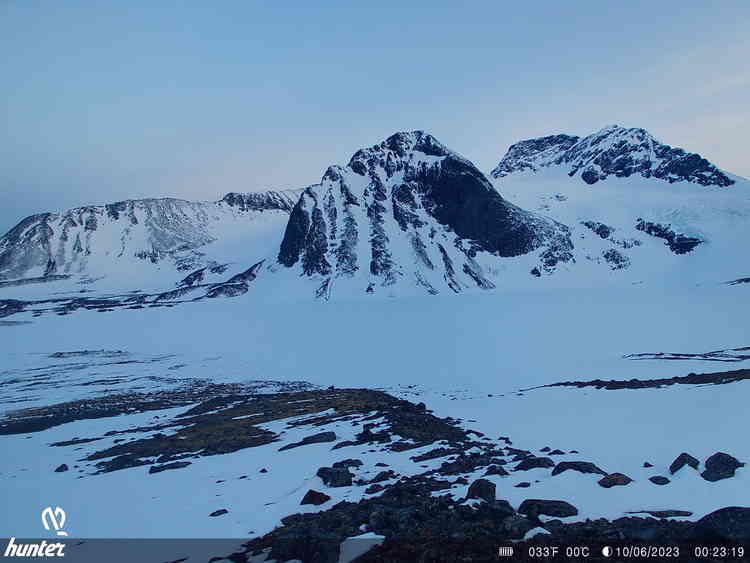Nina Kirchner, Annika Granebeck, Jamie Barnett, Daniella Lillieroth Charalambous, Maja Oscarsson
This dataset contains images of Lake Tarfala taken every 2 hours during the period from 10 June, 2023 to 24 July, 2023. During this period, the surface of Lake Tarfala transitions from being ice-covered to ice-free, an event referred to as "ice-off".
The dataset can be used to observe the ice-off event and to assign a date (or, rather, a time interval) to it. Knowledge of lake ice phenology, i.e. seasonal formation and loss of the lacustrine ice cover, is of importance since the timing of ice-off impacts lake processes such as stratification and vertical mixing.
The pictures were acquired using a camera positioned on the mountain flank along Lake Tarfala’s north-eastern shore, at 1220 m above sea level. In total, there are 537 images.
Download data
Image preview
Move the time slider to change image preview.

Scientific highlights
This dataset allows to assign a precise date to the ice-off event at Lake Tarfala in summer 2023. Defining ice-off as the first occasion after the ice-covered winter season on which the lake becomes completely ice-free and remains so for the rest of the summer, it was attained on 24 July, 2023.
Precise knowledge of the ice-off date can be used to:
- Assist in understanding of lake mixing processes.
- Better constrain numerical models computing ice-off.
- Provide a complement to ice-off dates derived from satellite imagery, which is notoriously difficult in polar alpine environments.
- Lend support to alternative definitions of ice-off.
- Contribute to knowledge of lake ice phenology in high altitude artic environments under current climate change.
Some notable events in the time-lapse imagery of the diminishing lake ice cover include:
- 11 June: Commence of ice cover melt in the northwestern lake corner where Kebnepakte Glacier drains into Lake Tarfala (picture 11).
- 12 June: Increasing number of melt features on the central lake ice cover, mimicking surface meltwater ponds (picture 35). Similar melt patterns also occurred earlier in the season (11-27 May 2023, not contained in this dataset but available upon request).
- 22 June: Inflow of sediment-rich streamwater from stream network on the eastern lake bank (left margin of picture 155 and 156). Repeated occurrence of the phenomenon can be seen on 17 July (picture 446).
- 24 June: Gradual retreat of ice cover along the eastern lake shoreline where stream water from southeastern Kaskasatjåkka glacier drains into Lake Tarfala (starting in foreground of picture 180).
- 3 – 17 July: Weakening of central ice cover through cracking and melting (e.g. pictures 280, 392) followed by rapid onset of lakewide drift and disintegration of ice floes (picture 405). Only the northeastern lake bay remains ice covered (observe snowfield adjacent to lake shoreline does not constitute part of ice cover).
- 19 July: Detachment of final large ice floe from northeastern lake bay followed by subsequent drift (picture 474).
Picture numbers in the scientific highlights correspond to picture numbers in the dataset.
Note that the camera produces black-white images under certain light conditions, such as under some low-visibility weather conditions.
Citation
Nina Kirchner, Annika Granebeck, Jamie Barnett, Daniella Lillieroth Charalambous, Maja Oscarsson (2023) Time lapse imagery of the ice-off event at Lake Tarfala, Kebnekaise Mountains, northern Sweden, summer 2023. Dataset version 1. Bolin Centre Database. https://doi.org/10.17043/tarfala-kirchner-2023-ice-off-2023-1
References
Kirchner, N., Weckström, J., Jansen, J., Schenk, F., Barnett, J., Granebeck, A., Leppäranta, M., Korhola, A. (2023). Water temperature, mixing and ice phenology in the arctic-alpine lake Darfáljávri (Lake Tarfala), northern Sweden, Arctic, Antarctic and Alpine Research. [In review].
Data description
The dataset consists of image files (JPG) of Lake Tarfala, with the date and time (Swedish daylight saving time, UTC+2) included in each photo. Image file names are numbered in chronological order.
The pictures were acquired using a camera positioned on the mountain flank along Lake Tarfala’s north-eastern shore, at ~67.9° N, 18.6° E, at 1220 m above sea level.
The data were collected using a Hunter Orion Trail Camera 4G. The camera elevation is 1.8 m above ground. Each JPG file has a size of ~2.4 MB. The total size of the dataset is ~1.23 GB.
During a few short periods, fog, snow and/or rain obscures the view of the lake.
Comments
The support of our co-workers on the Arctic Avenue activity Lake thermal and mixing dynamics under changing climate (J. Weckström, K. Weckström, A. Korhola, and F. Schenk) is gratefully acknowledged.
